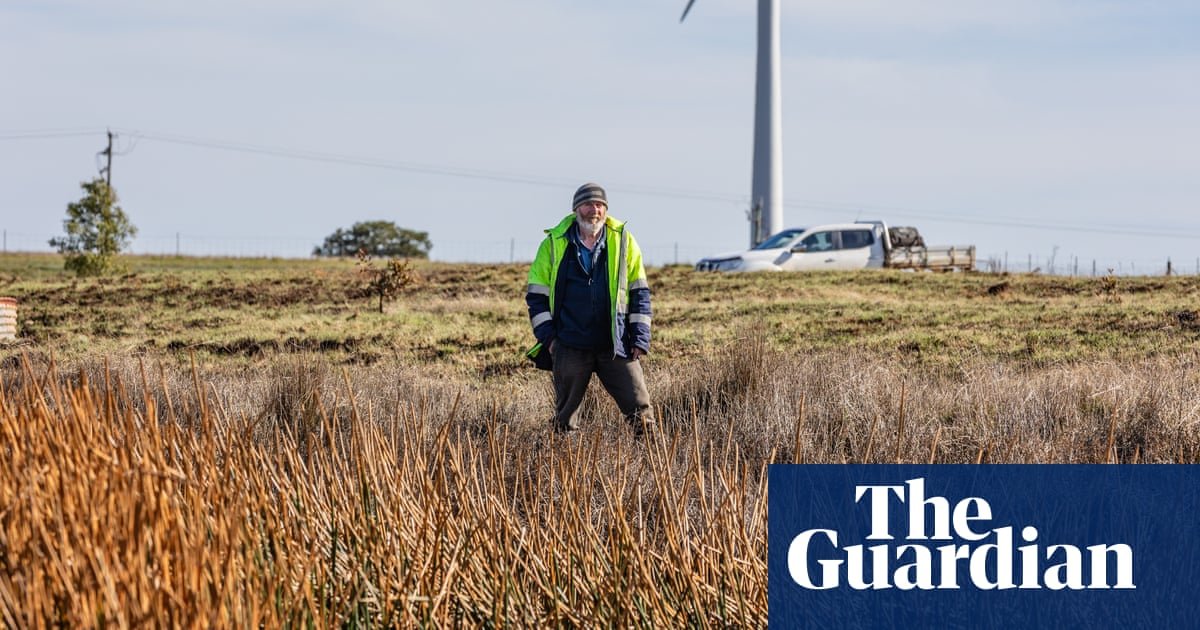The vast, windy plains of Neville Oddie’s property in Chepstowe offer a lesson in biodiversity. One by one, the fourth-generation Pyrenees farmer lifts the rippled roofing tiles scattered across the grasslands, revealing little whip snakes and lizards. But the jewel in the crown of this privately owned farmland is a population of brolgas.
The tall waterbirds are listed as a threatened species in Victoria. According to Birdlife Australia, the 2024 flock count sat at just over 800. Numbers in northern Australia are significantly higher.
While loss of wetlands is threatening the brolgas’ habitat, researchers have recently been investigating another possible risk to the birds: the development of windfarms.
Photograph: Wabi/Alamy
Protecting brolga habitat has become a rallying point for communities opposing windfarm developments in western Victoria. But Oddie, who hosts three turbines on his 730-hectare (1,800-acre) property, as well as extensive brolga habitat, says it’s not a question of having one or the other.
Victoria’s brolga population has reduced historically due to loss of wetlands from agricultural clearing and drainage, as well as overhunting in the 19th century. But numbers over the past decade have remained relatively stable thanks to various wetland rehabilitation projects.
An example of this sits on Oddie’s property. Seven years ago, he retrofitted his dam using money from windfarm developer Future Energy. The land isn’t grazed; there aren’t any livestock in sight, nor any trees around the dam’s perimeter. That makes it an ideal brolga habitat.
“Most landholders who’ve got brolgas value them [and] will also be protecting their wetlands and see them as very special to have,” Oddie says. “There’s a lot of other people who don’t care either because they haven’t got them or their attitude towards farming is totally different.”
“It’s really about raising the profile of not only brolgas but the whole bird community in terms of use of wetlands.”
Oddie says he has seen many brolgas feeding, nesting and breeding across his land despite the proximity to turbines, not only in the wetlands but in the dams beyond.
“I’m not going to sit here and say there is no issue whatsoever. I think it really comes down to local circumstances and local populations and local observations,” he says. “Beyond anything it comes back to the impacts on habitat and either the existence of that habitat, the removal of it or even the degradation of it.
“If it means that you reduce the density of the windfarms or you carefully choose the location so it’s not on a significant flight path or it’s not embedded in a whole lot of really important wetlands, it’s about making those sort of decisions as well.
“It doesn’t need to be one or the other. If it was the case here, if it was the windfarms or the brolgas, it would’ve been the brolgas.”
Buffer zones
The Victorian government is reviewing feedback on its draft Brolga Assessment and Mitigation Standards and says that by October, a program of targeted research will “fill gaps in our understanding of the impacts of wind energy on at-risk bird and bat species and inform development of standards and mitigation measures”.
That program will “identify characteristics of wetlands and their suitability for Brolga breeding sites, to inform assessments and develop recommended buffers,” the government says, to “update and clarify the government’s regulatory approach”.
Research by Inka Veltheim, who led the three-year South West Brolga Research Project, identified the proliferation of wind turbines as “a new emerging threat” due to associated habitat loss and risk of fatal collisions. She made a series of recommendations for windfarm developers, stating that with appropriate turbine-free buffers to avoid collision and disturbance there should be “zero net impact” on brolga populations.
Veltheim, who now works for the Victorian government, fitted satellite transmitters to a number of brolgas to investigate their movements, spatial requirements and vulnerability to collision with human-made structures. She wrote in her published research that understanding brolga movement behaviour, distribution and habitat use would increase knowledge, aid conservation planning and assist with windfarm impact mitigation.
after newsletter promotion
‘The wildlife can return’
Nature Glenelg Trust principal ecologist, Lachlan Farrington, says the rate of wetland loss across Victoria has been “huge”, with estimates indicating that 50% were lost since to European settlement.
“A lot of [the wetlands] remain compromised or drained,” Farrington says. “Our focus is working with private landholders to hold the water back.
“A lot of the [properties] we’ve worked on haven’t been able to be farmed effectively, so the landholders are keen to bring them back to life. If we can get water back in them, they tend to respond really well and with that, the wildlife can return.”
In June, Nature Glenelg Trust was awarded further funding to expand the Walker Swamp Restoration Reserve.
Elmoby Ecology principal ecologist, Emma Bennett, says the draining of ephemeral wetlands and the creation of dams has been the biggest factor in the brolga’s demise. She says investment in restoring wetlands “will be welcomed by the brolga”.
Birdlife Australia public affairs manager, Sean Dooley, says while there is no evidence currently that windfarm construction was affecting the brolgas, there needed to be strong restrictions on where infrastructure should be built.
But he said the most significant thing the community could do was work towards reducing the severity of climate change and the protection and rehabilitation of wetlands.
“There are many other potential threats including inappropriately sited turbines, however, the impact of windfarms on brolgas will be a moot point if all the suitable wetlands have dried out and the brolgas are gone,” he says.
Oddie says restoring wetlands involves a trade-off in the agricultural value of the land and it’s up to landholders to be prepared to make that sacrifice.
“We can come up with creative solutions,” he says.
